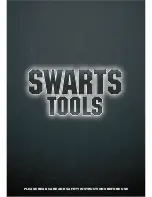
INSTRUCTION BOOKLET
INSTRUCTION BOOKLET
12
NORMAL CUTTING OPERATION
1.
Connect the plug to the power point. Switch on the laser light on/off switch (2).
2.
Clamp the work piece in position using the laser line to align the blade with the pencil mark on the work piece and
switch on the motor.
3.
Press the release latch (35).
4.
Lower the saw head.
5.
Press the switch trigger.
6.
When the blade is at its maximum speed (within approximately 2 seconds) lower the blade through the work piece.
After completing the cut, release the switch trigger (24), stop the motor and blade, switch off the laser light on/off
switch (2).
7.
With the saw arm (5) in the raised position, use a soft brush to dust away the sawdust build-up around the
assembly.
NOTE!
Wear eye and respiratory protection whilst brushing the dust away.
CROSS-CUTTING (WITHOUT SLIDE ACTION)
When cutting a narrow piece of wood it is not necessary to use the slide mechanism. In these cases ensure that the slide
lock (29) is screwed down to prevent the saw arm from sliding.
1.
A crosscut is made by cutting across the grain of the work piece. A 90° crosscut is made with the mitre table set at
0 degrees. Mitre crosscuts are made with the table set at some angle other than zero. Pull on the release knob (6)
and lift the saw arm (5) to its full height.
2.
Loosen the mitre lock (25).
Rotate the mitre table (21) until the pointer aligns the desired angle
Re-tighten the mitre lock (25)
WARNING!
Be sure to tighten the mitre lock before making a cut. Failure to do so could result in the table moving
during the cut and cause serious personal injury. Place the work piece flat on the table with one edge securely
against the fence (18). If the board is warped, place the convex side against the fence otherwise the board could
break and jam the blade.
3.
When cutting long pieces of timber, support the opposite end of the timber with the side support bars (36), a roller
stand or a work surface that is level with the saw table.


































